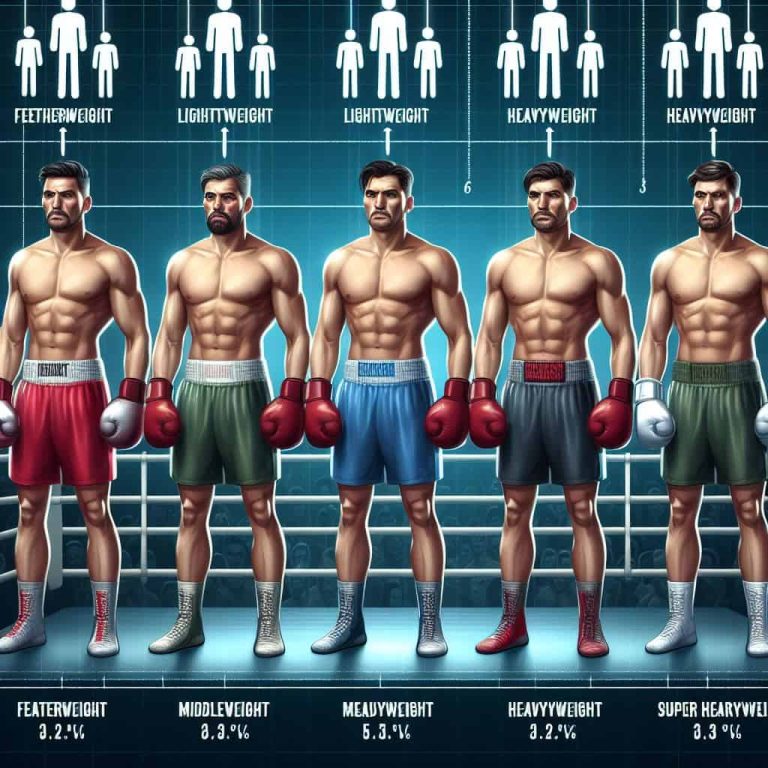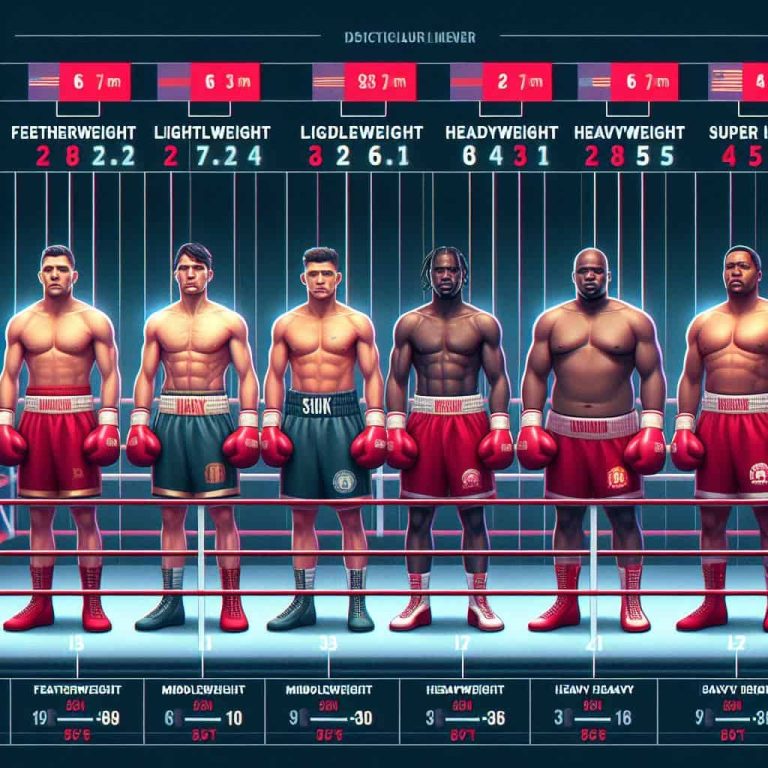Boxing Weight Classes Chart
Boxing, like many combat sports, operates under a strict system of weight classes to ensure fair competition and safety for its athletes. These weight divisions categorize boxers based on their body weight, allowing them to compete against opponents of similar size and strength. Let’s delve into the world of boxing weight classes and explore their significance in the sport.

| Weight Class | Weight Limit (lbs) | Weight Limit (kg) | Weight Limit (stones) | Established | Description |
|---|---|---|---|---|---|
| Heavyweight | Unlimited | – | – | 1738 | No weight limit, pinnacle of professional boxing |
| Cruiserweight | 200 | 90.72 | 14 st 4 lb | 1979 | Between light heavyweight and heavyweight |
| Light Heavyweight | 175 | 79.38 | 12 st 7 lb | 1903 | Just below cruiserweight |
| Super Middleweight | 168 | 76.20 | 12 st | 1967 | Competitive division for skilled fighters |
| Middleweight | 160 | 72.57 | 11 st 6 lb | 1840 | Known for speed, agility, and power |
| Super Welterweight | 154 | 69.85 | 11 st | 1920 | Also known as junior middleweight, features skilled boxers |
| Welterweight | 147 | 66.68 | 10 st 7 lb | 1909 | Versatile fighters with a balanced mix of speed and strength |
| Super Lightweight | 140 | 63.50 | 10 st | 1962 | Competitive division for skilled fighters |
| Lightweight | 135 | 61.23 | 9 st 9 lb | 1738 | Known for speed and technical prowess |
| Super Featherweight | 130 | 58.97 | 9 st 4 lb | 1920 | Exciting weight class with skilled competitors |
Introduction to Boxing Weight Classes
In the realm of boxing, weight classes serve as a fundamental framework that categorizes fighters based on their body weight. This system aims to create balanced matchups where boxers are evenly matched in terms of size and physical attributes. By ensuring that competitors are within a certain weight range, boxing promotes fairness and reduces the risk of lopsided contests.
Evolution of Boxing Weight Classes
The concept of weight classes in boxing has evolved over time. Historically, there were fewer weight divisions, leading to disparities in size between opponents. As the sport progressed, governing bodies like the World Boxing Council (WBC), World Boxing Association (WBA), and International Boxing Federation (IBF) introduced more weight categories to accommodate a wider range of athletes.
Current Boxing Weight Class Chart
Today, boxing features a comprehensive chart of weight classes, each with its own set of limits. From the featherweight division to the heavyweight division, boxers compete within specified weight ranges to ensure competitive equity. The following is a breakdown of the main weight classes recognized in professional boxing:
- Heavyweight: No weight limit
- Cruiserweight: 200 lbs (90.72 kg)
- Light Heavyweight: 175 lbs (79.38 kg)
- Super Middleweight: 168 lbs (76.20 kg)
- Middleweight: 160 lbs (72.57 kg)
- Super Welterweight: 154 lbs (69.85 kg)
- Welterweight: 147 lbs (66.68 kg)
- Super Lightweight (Junior Welterweight): 140 lbs (63.50 kg)
- Lightweight: 135 lbs (61.23 kg)
- Super Featherweight (Junior Lightweight): 130 lbs (58.97 kg)
- Featherweight: 126 lbs (57.15 kg)
- Super Bantamweight (Junior Featherweight): 122 lbs (55.34 kg)
- Bantamweight: 118 lbs (53.52 kg)
- Super Flyweight (Junior Bantamweight): 115 lbs (52.16 kg)
- Flyweight: 112 lbs (50.80 kg)
- Light Flyweight (Junior Flyweight): 108 lbs (48.99 kg)
- Minimumweight (Mini Flyweight): 105 lbs (47.63 kg)
Amateur Boxing Weight Classes
| Weight Class | Weight Limit (lbs) | Weight Limit (kg) | Weight Limit (stones) | Glove Sizes (Professional) | Glove Sizes (Amateur) |
|---|---|---|---|---|---|
| Strawweight | 105 | 47.7 | 7 st 7 lb | 8 oz | 10-12 oz |
| Super Strawweight | 105.1 – 108 | 47.77 – 49 | 7 st 7 lb – 7 st 10 lb | 8 oz | 10-12 oz |
| Flyweight | 108.1 – 112 | 49.13 – 50.90 | 7 st 10 lb – 8 st | 8 oz | 10-12 oz |
| Super Flyweight | 112.1 – 115 | 50.95 – 52.27 | 8 st – 8 st 3 lb | 8 oz | 10-12 oz |
| Bantamweight | 115.1 – 118 | 52.31 – 53.63 | 8 st 3 lb – 8 st 6 lb | 8 oz | 10-12 oz |
| Super Bantamweight | 118.1 – 122 | 53.68 – 55.45 | 8 st 6 lb – 8 st 10 lb | 8 oz | 10-12 oz |
| Featherweight | 122.1 – 126 | 55.5 – 57.27 | 8 st 10 lb – 9 st 1 lb | 8 oz | 10-12 oz |
| Super Featherweight | 126.1 – 130 | 57.27 – 59.09 | 9 st 1 lb – 9 st 4 lb | 8 oz | 10-12 oz |
| Lightweight | 130.1 – 135 | 59.13 – 61.36 | 9 st 4 lb – 9 st 9 lb | 8 oz | 10-12 oz |
| Super Lightweight | 135.1 – 140 | 61.40 – 63.63 | 9 st 9 lb – 10 st | 8 oz | 10-12 oz |
| Welterweight | 140.1 – 147 | 63.68 – 66.81 | 10 st – 10 st 7 lb | 8 oz | 10-12 oz |
| Super Welterweight | 147.1 – 154 | 66.86 – 70 | 10 st 7 lb – 11 st | 10 oz | 10-12 oz |
| Middleweight | 154.1 – 160 | 70.1 – 72.72 | 11 st – 11 st 4 lb | 10 oz | 10-12 oz |
| Super Middleweight | 160.1 – 168 | 72.77 – 76.36 | 11 st 4 lb – 12 st | 10 oz | 10-12 oz |
| Light Heavyweight | 168.1 – 175 | 76.40 – 79.54 | 12 st – 12 st 7 lb | 10 oz | 10-12 oz |
| Cruiserweight | 175.1 – 200 | 79.59 – 90.90 | 12 st 7 lb – 14 st 4 lb | 10 oz | 10-12 oz |
| Super Cruiserweight | 200.1 – 225 | 90.95 – 102.27 | 14 st 4 lb – 16 st 1 lb | 10 oz | 10-12 oz |
| Heavyweight | 225.1 and above | 102.31 and above | 16 st 1 lb and above | 10 oz | 10-12 oz |
Boxing Weight Classes Champions
| Weight Class | WBC Champion | WBA Champion | IBF Champion | WBO Champion | Lineal Champion |
|---|---|---|---|---|---|
| Heavyweight | Tyson Fury | Oleksandr Usyk | Oleksandr Usyk | Oleksandr Usyk | Tyson Fury |
| Cruiserweight | Ilunga Makabu | Ryad Merhy | Lawrence Okolie | Arsen Goulamirian | Oleksandr Usyk |
| Light Heavyweight | Artur Beterbiev | Dmitry Bivol | Artur Beterbiev | Joe Smith Jr. | – |
| Super Middleweight | David Benavidez | David Morrell Jr. | Canelo Álvarez | Billy Joe Saunders | – |
| Middleweight | Jermall Charlo | Ryota Murata | Gennady Golovkin | Demetrius Andrade | – |
| Super Welterweight | Jermell Charlo | Erislandy Lara | Jermell Charlo | Brian Castaño | – |
| Welterweight | Errol Spence Jr. | Yordenis Ugas | Errol Spence Jr. | Terence Crawford | – |
| Super Lightweight | José Ramírez | Mario Barrios | Josh Taylor | Josh Taylor | – |
| Lightweight | Devin Haney | George Kambosos Jr. | George Kambosos Jr. | Teófimo López | – |
| Super Featherweight | Oscar Valdez | Roger Gutiérrez | Joseph Diaz Jr. | Oscar Valdez | – |
Boxing Weight Classes UK
| Weight Class | Weight Limit (lbs) | Weight Limit (kg) | Weight Limit (stones) | Description |
|---|---|---|---|---|
| Heavyweight | Unlimited | – | – | The pinnacle of professional boxing, no upper weight limit |
| Cruiserweight | 200 | 90.72 | 14 st 4 lb | Division between light heavyweight and heavyweight, competitive fights within this weight range |
| Light Heavyweight | 175 | 79.38 | 12 st 7 lb | Skilled fighters just below cruiserweight |
| Super Middleweight | 168 | 76.2 | 12 st | Competitive division showcasing talent |
| Middleweight | 160 | 72.57 | 11 st 6 lb | Known for speed, agility, and power |
| Super Welterweight | 154 | 69.85 | 11 st | Also called junior middleweight |
| Welterweight | 147 | 66.68 | 10 st 7 lb | Versatile fighters with balanced skills |
| Super Lightweight | 140 | 63.5 | 10 st | Competitive division for skilled boxers |
| Lightweight | 135 | 61.23 | 9 st 9 lb | Known for speed and technical prowess |
| Super Featherweight | 130 | 58.97 | 9 st 4 lb | Exciting weight class for skilled fighters |
These weight classes in the United Kingdom, like in professional and amateur boxing worldwide, ensure fair competition and allow boxers to compete within their weight range.
Boxing Weight Classes In Stone
| Weight Class | Weight Limit (Stones) | Weight Range (lbs) | Description |
|---|---|---|---|
| Featherweight | 10-11 stones | 140-154 lbs | Fighters in the featherweight class compete within this weight range |
| Lightweight | 11-12 stones | 154-168 lbs | Lightweight boxers showcase their skills in this division |
| Welterweight | 12-13 stones | 168-182 lbs | Versatile fighters with a balanced mix of speed and strength compete as welterweights |
| Middleweight | 13-14 stones | 182-196 lbs | Middleweights exhibit their talents in this competitive weight class |
| Super Middleweight | 14-15 stones | 196-210 lbs | Competitors in the super middleweight division battle it out within this weight range |
| Light Heavyweight | 15-16 stones | 210-224 lbs | Light heavyweights demonstrate their skills in the ring |
| Cruiserweight | 16 stones plus | 224 lbs and above | Cruiserweights compete in this division, showcasing their abilities |
| Heavyweight | No upper limit | Unlimited | The heavyweight division has no boundaries, making it the pinnacle of professional boxing |
These weight classes in terms of stones provide a clear framework for fair competition in boxing, allowing fighters to compete within their respective weight ranges.
Olympic Boxing Weight Classes
| Weight Classes for Olympic Boxing at Paris 2024 | |
|---|---|
| Men’s Weight Classes | Women’s Weight Classes |
| 51 kg | 50 kg |
| 57 kg | 54 kg |
| 63.5 kg | 57 kg |
| 71 kg | 60 kg |
| 80 kg | 66 kg |
| 92 kg | 75 kg |
| +92 kg |
The Olympic Games Paris 2024 will feature 13 weight categories in Boxing, with seven weight classes for men and six for women. These weight divisions ensure a balanced representation of athletes and provide opportunities for boxers to compete in their respective weight ranges

Significance of Weight Classes in Boxing
The establishment of weight classes is crucial for maintaining the integrity and safety of boxing matches. By grouping fighters based on their weight, promoters can arrange bouts that are competitive and compelling for audiences. Additionally, weight classes mitigate the risk of injuries by preventing mismatches between boxers with significant size discrepancies.
Popular Boxers in Different Weight Classes
Throughout boxing history, numerous legendary fighters have left their mark on different weight divisions. From the heavyweight reign of Muhammad Ali to the dominance of Floyd Mayweather Jr. in multiple weight classes, these athletes have captivated audiences with their skill and tenacity. Whether it’s the power of Mike Tyson in the heavyweight division or the speed of Manny Pacquiao in lower weight classes, each boxer brings a unique style to their respective category.
Training and Dieting for Specific Weight Classes
Competing in a specific weight class requires careful preparation and discipline from boxers. Training regimens often include a combination of cardiovascular exercises, strength training, and sparring sessions to optimize performance while maintaining weight. Additionally, boxers may follow strict dietary plans to reach their desired weight without sacrificing muscle mass or endurance.
Controversies Surrounding Weight Cutting
Despite the benefits of weight classes, the practice of weight cutting has sparked controversy within the boxing community. Some fighters resort to extreme measures, such as dehydration and starvation, to make weight before a bout. These methods pose serious health risks and raise ethical concerns about the well-being of athletes. Organizations like the Association of Boxing Commissions (ABC) have implemented regulations to address these issues and promote safer practices.
The Role of Weight Classes in Boxing Promotions
Weight classes play a significant role in shaping the landscape of boxing promotions. Matchmakers carefully consider weight differentials when arranging fights to ensure competitive matchups that appeal to fans. Additionally, marketing strategies often highlight the rivalry between champions in different weight divisions, leading to high-profile events and increased revenue for promoters.
Impact of Weight Classes on Boxing Fans
For boxing enthusiasts, weight classes offer a diverse range of matchups and styles to enjoy. Whether it’s the raw power of heavyweights trading blows or the lightning-fast combinations of lighter weight classes, each division has its own allure. Fans develop allegiances to fighters in specific weight categories, fueling excitement and anticipation for upcoming bouts.
Future Trends in Boxing Weight Classes
As the sport of boxing continues to evolve, we may see changes in the landscape of weight classes. With advancements in training techniques and nutrition science, athletes may have more flexibility in transitioning between weight divisions. Additionally, there could be discussions about introducing new weight classes to accommodate the growing diversity of fighters entering the sport.
Conclusion
In conclusion, boxing weight classes serve as a cornerstone of the sport’s structure, ensuring fair competition and safety for all participants. From the heavyweight giants to the nimble flyweights, each division offers its own brand of excitement and athleticism. As boxing continues to adapt to modern challenges, the significance of weight classes remains steadfast in shaping the future of the sport.
FAQs
- What is the purpose of weight classes in boxing? Weight classes categorize boxers based on their body weight, promoting fair competition and reducing the risk of mismatches.
- How are weight classes determined in boxing? Boxing organizations like the WBC, WBA, and IBF establish weight classes and their respective limits through regulations and guidelines.
- Can boxers move between weight classes? Yes, boxers can move between weight classes by adjusting their training, diet, and physique to meet the requirements of a new division.
- Are there any weight classes unique to women’s boxing? Women’s boxing features the same weight classes as men’s boxing, allowing female athletes to compete across a range of divisions.
- How often do weight class regulations change in boxing? Weight class regulations may change periodically based on the decisions of governing bodies and the evolving needs of the sport.




